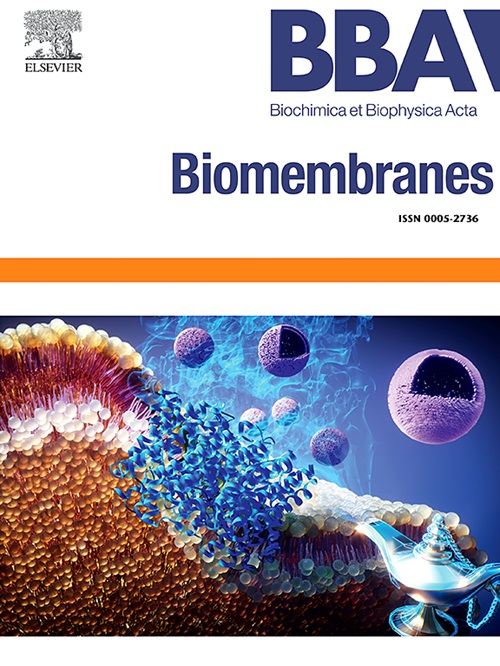生理相关脂质膜中紫红质寡聚和g蛋白偶联的小角中子散射研究。
IF 2.5
3区 生物学
Q3 BIOCHEMISTRY & MOLECULAR BIOLOGY
引用次数: 0
摘要
尽管G蛋白偶联受体(gpcr)的寡聚状态和与同源G蛋白的相互作用是其信号转导能力的核心,但它们仍然不明确。在这项研究中,我们使用小角中子散射(SANS)和中子对比匹配方法来阐明原型GPCR,视紫红质的寡聚态及其与G蛋白转导蛋白(Gt)的相互作用。当视紫红质/脂质摩尔比为1/360时,我们发现适应黑暗的视紫红质以单体形式存在,这一发现与分光光度法光活化测量的高功能活性和催化[35S]-GTP-γ-S交换速率一致。在光激活后,我们观察到视紫红质与Gt形成稳定的1:1的化学计量复合物,其结构与最近的冷冻电镜数据一致。相反,在没有Gt的情况下,激活的视紫红质倾向于形成高阶低聚物。本研究强调了视紫红质寡聚化的浓度依赖性,并建立了SANS和产生适当对比匹配样品的能力,作为在生物学相关条件下表征整体膜蛋白相互作用的强大策略。本文章由计算机程序翻译,如有差异,请以英文原文为准。

Small angle neutron scattering study of rhodopsin oligomerization and G-protein coupling in a physiologically relevant lipid membrane
Although the oligomeric states of G-protein-coupled receptors (GPCRs) and interactions with cognate G proteins are central to their signal transduction capabilities, they remain poorly defined. In this study, we used small-angle neutron scattering (SANS) and a neutron contrast matching approach to elucidate the oligomeric states of the archetypal GPCR, rhodopsin, and its interaction with the G protein transducin (Gt). At a rhodopsin/lipid molar ratio of 1/360, we found that dark-adapted rhodopsin exists as a monomer, a finding consistent with its high functional activity measured upon photoactivation by spectrophotometry and the rate of catalyzed [35S]-GTP-γ-S exchange. Following light activation, we observed that rhodopsin forms a stable 1:1 stoichiometric complex with Gt, the structure of which is consistent with recent cryo-EM data. In contrast, activated rhodopsin in the absence of Gt showed a propensity to form higher order oligomers. This research underscores the concentration-dependent nature of rhodopsin oligomerization and establishes SANS and the ability to produce appropriately contrast-matched samples, as a robust strategy for characterizing integral membrane protein interactions under biologically relevant conditions.
求助全文
通过发布文献求助,成功后即可免费获取论文全文。
去求助
来源期刊

Biochimica et biophysica acta. Biomembranes
生物-生化与分子生物学
CiteScore
8.20
自引率
5.90%
发文量
175
审稿时长
2.3 months
期刊介绍:
BBA Biomembranes has its main focus on membrane structure, function and biomolecular organization, membrane proteins, receptors, channels and anchors, fluidity and composition, model membranes and liposomes, membrane surface studies and ligand interactions, transport studies, and membrane dynamics.
 求助内容:
求助内容: 应助结果提醒方式:
应助结果提醒方式:


